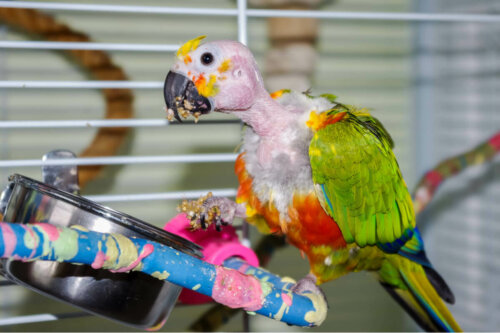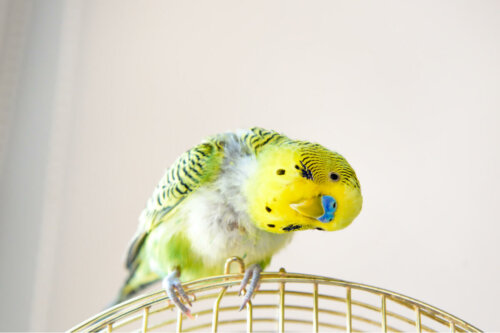Causes and Treatment of Feather Pecking in Birds

Feather pecking is a common clinical condition in domestic birds. It’s difficult to eradicate and causes many problems, both to the animal and their owner. Continue reading for more details about it and what you can do to deter it.
The following lines are a review of the causes, symptoms, and treatment for this problem. It’s of vital importance to prevent or to know how to treat feather pecking if you have a bird at home as the condition could easily worsen over time.
What’s feather pecking?
This kind of itching in birds is a behavioral disorder. A bird with it has a repetitive, constant behavior with no obvious function in which they pluck their own feathers. It differs from molting and other conditions in that only the feathers from the areas the bird can reach with its beak disappear.
The chronic form of this behavior qualifies as obsessive-compulsive disorder. The bird may do it to themselves or to others. This is why it’s important to watch them closely at all times and separate cage mates temporarily if necessary.
There’s a logical way to know who’s doing it to whom. Is the bird missing the feathers from its head? Their cellmate is the aggressor in that case. This is because they can’t pluck their own head!

Causes of feather pecking in birds
The origin of this condition is birds’ preening behavior. It’s innate and triggered in response to skin receptors – which report that some feathers are misplaced – or by a stress control mechanism. There are four main causes of pecking in birds:
- Genetic. Some species seem to be more predisposed to this disorder, such as certain psittacines. This, however, remains to be proven.
- Diseases. Be it internal or external parasites, malnutrition, allergies, or skin and liver conditions.
- Environmental causes. Poor cage placement, lack or excess of bathing, or alterations in the photoperiod.
- Compulsive behaviors. These are the best known and consist of the bird removing their feathers due to anxiety and/or depression. This is usually triggered by lack of enrichment, death, or separation from a partner or human owner. This can also be caused by the stress derived from removing the animal from its natural environment, among other things.
OK, but, how do you detect feather pecking in birds? Just keep reading!
Symptoms of feather pecking
Losing feathers isn’t the only sign that your bird may be suffering from feather pecking. It’s important to be able to distinguish it from normal molting in order to make a correct diagnosis. Thus, look for the following to make it easier for your vet:
- Featherless areas within reach of their beak
- Broken or poorly cared-for feathers, as birds may not pluck the whole feather, but just the end
- Rubbing the legs against perches or other surfaces is a less frequent behavior but they sometimes pluck the leg feathers this way
- Occasionally, birds may also pick at their claws and feet and produce wounds
Treatment
What should you do once you identify the problem and its causes? The solution is to administer the necessary treatment if the cause is organic, and the behavior should disappear after that.
Something similar happens when the cause is environmental: the most important thing here is to recognize the factors that are stressing the bird. Some measures you can take are:
- Keeping the low ambient noise level to a minimum
- Light cycles should allow the bird to rest
- Using a suitable cage and placing it in a high place to avoid the feeling of vulnerability (the size should be adequate and allow the bird to move around so as not to be bored in it)
- You must properly sanitize their food in order to avoid diseases
Eliminate the presence of predators or other animals. For instance, that magpie who perches on the terrace to watch your canary is thinking up ways to eat it, and your bird knows it. It may also be that your bird is afraid of the dog, no matter how sweet they are.
Measures such as creating a daily routine, improving feeding, and rotating enrichment so that the bird doesn’t get bored should be the most immediate ones to take when the cause is purely behavioral.
In very extreme cases, you can resort to an Elizabethan collar as it’ll impose some physiological limitations and the bird won’t be able to peck their feathers. Unfortunately, this collar is highly uncomfortable and won’t allow them to move or eat at ease.
Homeopathic remedies and acupuncture are the treatments currently under study. Also, acupuncture seems to be effective in some species such as cockatiels.
The importance of asking for help
Birds have complex personalities, so treatment for this type of problem must be tailored to each individual. Consulting a professional should always be the first option when the behavior begins as it’s difficult to diagnose and eliminate completely. Relapses are frequent, unfortunately.
We must conclude with a thought: is a caged bird happy? Sometimes, taking a bird into the home is the best option for them but you must keep in mind that these aren’t domesticated species.

Before sharing your life and space with a bird, try to make sure you have the tools for them to be completely happy and healthy in your company and those around you.
All cited sources were thoroughly reviewed by our team to ensure their quality, reliability, currency, and validity. The bibliography of this article was considered reliable and of academic or scientific accuracy.
HEIDENREICH, B. Solving companion parrot behaviour problems In: Proceedings of the 26th annual conference, ed. Association of avian veterinarians, 2005; 219-227
Bargalló, F., Moura, A. S., García, C., Grífols i Ronda, J., & Martínez Silvestre, A. (2021). Picaje en aves psitácidas. AV exóticos. http://axonveterinaria.net/web_axoncomunicacion/auxiliarveterinario/17/av17_Picaje_aves_psitacidas.pdf